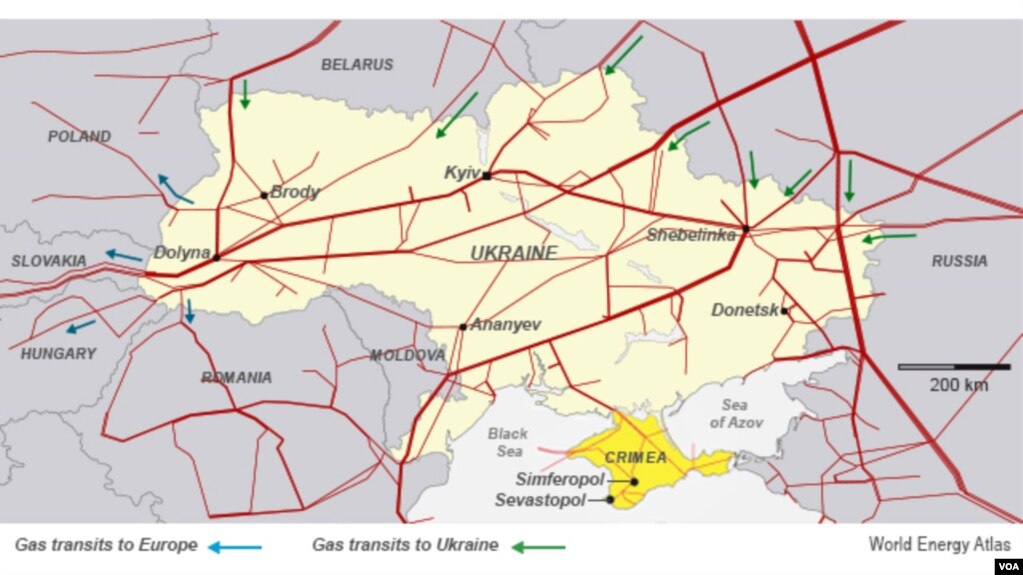
Hello, once again, and welcome. I’m Jim Tedder in Washington. It’s time to learn and improve your American English and learn about the world at the same time.
Today politics and energy mix. First we will hear how Russia is increasing the price of natural gas in Ukraine. Can the United States come to the rescue?
Then the United Nations says the world must act faster to keep climate change from doing more harm.
As It Is …is on the air, from VOA!
Russia continues to increase the price of natural gas it sells to Ukraine. This has caused some countries to ask if natural gas from the U.S. could help Europe reduce or even end its dependence on Russia for energy. Experts say it would be a few years before such a plan could be put into place.
Jonathan Evans has been watching the story for us.
Russia Continues to Increase Price of Natural Gas
In their home near Kyiv, the capital of Ukraine, Svetlana Kuleshova and Yuri Kuleshov say they are being hurt by the increasing cost of natural gas from Russia.
He says it will directly affect our budget. We will simply stop buying all the things we are buying now, because in any case we will be forced to pay the gas bill as we have to at least heat the house in order not to freeze. We will start looking for alternatives, of course.
Many people who live in Europe have the same worries. Ukraine and six other European countries get all of their natural gas from Russia.

Igor Shuvalov is Russia’s first deputy prime minister. He says he is not worried about threats by those countries to buy natural gas from the United States. He says Russia can easily sell its natural gas to other countries. And he says it will be more costly for European countries to buy natural gas from the US.
“It will force Europeans to invest in new infrastructure to buy gas from the United States and other parts of the world. You will pay for this more. It will mean that the consumers will pay more, but Russian gas will be consumed by someone else in other areas of the world.”
American natural gas that flows through places like the eastern state of Maryland could help European countries, but not for a few years. At one of those terminals a new area is being built that will turn natural gas into liquid. Then the liquid can be shipped to Europe. But it is like similar plants being built in the US. It will not be completed until 2017. And when it does open, the terminal in Maryland will send all its gas to India and Japan.
Energy expert Paul Bledsoe is a senior fellow at the German Marshall Fund of the United States. He says other countries will provide natural gas to Europe before the U.S. does.
“The first places are going to be a southern pipeline from Central Asia, from North Africa, and from their own resources. What we’re talking about, though, is broadening the available resources globally for gas generally, essentially globalizing the natural gas market.”
Mr. Bledsoe says the United States should move quickly on request by European countries to import natural gas from the US. And he says the US should help Europe develop its own sources of natural gas from shale gas.
“What we’re really calling for is a joint US-EU plan on natural gas, to diversify the sources of gas for Europe, to reduce long-term prices, to cut emissions and cut dependence on Russia. There’s a tremendous opportunity here.”
Steve LeVine is a professor at Georgetown University in Washington and a fellow at the New America Foundation. He writes about energy for the website Quartz. He says it will be good for both Europe and the United States when Europe reduces its dependence on Russia.
“The impact of putting ((exporting)) all this gas, and the signal that it’s sending, is going to be to increase U.S. influence in the world, geopolitical influence from this natural gas.”
Professor LeVine says Russian President Vladimir Putin will then have to sell natural gas to China which will demand a lower price.
I’m Jonathan Evans.
Action on Climate Change Cannot Wait
A United Nations report says countries should act faster to control the effects of climate change. It says we should change from burning fossil fuels like coal to cleaner energy sources.
The Intergovernmental Panel on Climate Change, or IPCC, released the report this week after a meeting of scientists and representatives of governments. This follows the recent release of two other IPCC reports on climate change.
Those say what the group believes is the reality of climate change, and its effect on the environment.
Christopher Cruise takes the story from there.
The answer to the climate problem could start with a huge solar project in the Mohave Desert, in the western American state of California. A company called NRG Energy began operating the project in February. NRG Energy President David Crane says it will provide enough electricity for 140,000 homes. He says that is a good start.
“Our generation of leadership can get the ball rolling in fighting against climate change so that the next generation -- the people who are in their 20s and 30s today -- can finish the job.”
Rajendra Pachauri is the chairman of the Intergovernmental Panel on Climate Change. He says projects like the one in California should be put in place worldwide. He says the report shows that is one way we can reduce climate change.
“If we really want to bring about a limitation of temperature increase to no more than two degrees Celsius, then this is the message that comes out very clearly from this report.”
The report says global greenhouse gas emissions must be lessened by 40 to 70 percent by the middle of this century. The goal is to prevent severe effects from strong weather events in a warmer world.
Nathaniel Koehane works at the Environmental Defense Fund. He leads efforts there to limit climate change. He told VOA on Skype that changes can be made that will help stop the severe effects of climate change.
“There are a handful of things -- around energy efficiency, renewable energy, reducing deforestation -- a handful of things that the world could do and we could help turn the corner by 2020 and get on track to reduce emissions enough to keep the climate safe.”
Renewable energy sources like solar, wind and hydropower create 8.5 percent of the world’s energy. Nuclear power creates about 11.5 percent.
Mr. Koehane says the report shows some countries are not making the change from fossil fuels to cleaner energy.
“When you look at the stats and the data in the report, it shows, for example, that coal has been growing faster than other sources. So we need to reverse that trend and we do need to rapidly ramp up the sources of renewable power, the share of renewable power.”
The report says there will be a greater cost to public health and the environment if there continue to be delays in reducing emissions.
Mr. Koehane says voters must tell their leaders that reducing climate change is important to them. He says we have the knowledge and the technology to make changes. He is hopeful about the possibility of change.
“If we do get that political will and if we can push in that direction, that we have the technologies to get started on this problem. We just need everybody to pitch in.”
The report says there is still time for the international community to take actions to reduce climate change caused by human activity.
The U.N. is talking with countries about a new international agreement to reduce emissions worldwide. The agreement would take the place of the Kyoto Protocol on Climate Change, which ended in 2012.
I’m Christopher Cruise.
And I’m Jim Tedder in Washington.
Thank you for spending some time with us today on VOA.





